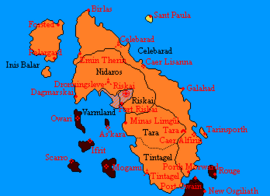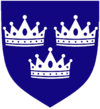Three Kingdoms
| The Three Kingdoms of Nidaros, Riskai and Celebarad Tar-Teirnased Nidaros, Riskai i Celebarad Dei Tre Kongeriki Nidaros, Riskai og Kelebarad | |||
| |||
| Motto: Unedic gani Tar Coron Einte gjennom Tri Kronor "United by the Three Crowns" | |||
| Anthem: | |||

| |||
| Map versions | |||
| Capital | Riskai | ||
| Largest city | Celebarad, Dronningsleve, Emin Therin | ||
| Official language(s) | Celebaradian Nidarosian Istvanistani | ||
| Official religion(s) | 50% Norse Nazarene 42% Followers of Arian 4% Calbain Church 4% other | ||
| Demonym | |||
| Adjective | |||
| Government | Monarchy (rotating First King as primus inter pares) | ||
| • First King | Finn II of Celebarad | ||
| • Queen | Mina of Nidaros | ||
| • King | Mondo of Riskai | ||
| Legislature | Council of Kings (executive and legislative) Conclave of the Three Kingdoms (advisory) | ||
| Establishment | 1723 AN | ||
| Area | 2.736.949 km2 | ||
| Population | Around 14 million | ||
| Currency | Crown | ||
| Abbreviation | TTK, 3K | ||
| Driving side | right | ||
| Time zone(s) | CMT+10 | ||
| National animal | Stag | ||
| National drink | |||
The Three Kingdoms of Nidaros, Riskai and Celebarad (also known in short as the Three Kingdoms) is a federation of three countries that together occupy the Northern part of Feanoria the coast of East Keltia in the Great Western Sea. The three constituent kingdoms of Nidaros, Riskai and Celebarad, unified under the Three Crowns retain a large degree of autonomy. The Three Kingdoms are governed by the three monarchs of the constituent realms: QueennMina of Nidaros, King Mondo of Riskai and King Finn II of Celebarad.
Etymology
The name of the Union comes from the unification of the three constituent kingdoms of Nidaros, Riskai and Celebarad. The name Nidaros derives from the Norse of "river mouth". The origin of the name Riskai remains unknown, but the name has been used since ancient times. The name Celebarad derives from the Menelmacari for Fortified Place of Silver, and is likely a reference to both the silver mines that lay in the North East of the Kingdom, and to the White Fortress of Celebarad. The name initially refered to the city of Celebarad, but gradually expanded to the wider Kingdom, in which case the name has taken to mean Land of Silver.
Constituent Kingdoms
Nidaros
For the main article: Nidaros
Nidaros is a kingdom on the north island of the Red Antilles (Feanoria). Before its dissolution by the hand of the Storish king, it was a client kingdom of Stormark, though largely self-governing and autonomous, with a culture, religion and legal considerably different from Stormark's main one. In 1723, the kingdom was re-established with help from Calbion, Celebarad, Riskai, and Varmland. Its claimed borders are the same as the "old" Nidaros, with the exception for the territories under Celebarad, Varmland and Riskai Proper.
Riskai
For the main article: Riskai
Riskai is a theocratic monarchy in eastern Keltia. Ruled by the House of Rossheim, for much of its history it has been a dependency of more powerful empires, notably Stormark and Minarboria. It has suzerainty over Varmland.
The King of Riskai also holds the counties of Tara and Tintagel as fiefs.
Celebarad
For the main article: Kingdom of Celebarad
The Kingdom of Celebarad is a constituent country of Calbion located on North Island in the Great Western Sea. The Kingdom was founded by the Inhabitants of the great city of Celebarad, after which the Kingdom was to be named. Celebarad is a client kingdom of Calbion. The Celebradi had been in relative isolation after the collapse of the Menelmacari homeland, and the subsequent subjugation of their land and city by the Vanics. When the Calbain arrived on the shores of North Island in 1692, they allied with the Celebaradi, who had significant knowledge of the mountains and forests of their island, in order to establish their trading ports. The Kingdom of Celebarad borders the Kingdoms of Nidaros and Riskai to the West.
Geography
Geographically, the Three Kingdoms cover the northern great island of the so-called Feanorian archipelago (also known as the Red Antilles or the Sólareyjar). Two of the Three Kingdoms – Nidaros and Riskai – are entirely located on this island. The third kingdom, Celebarad, also covers the island of Balar as well as Angár, Lycurgia, the Vraillan Islands and Krufnspire Island.
Government
The Three Kingdoms are governed by a council of the three kings. This council is presided over by the First King, a primus inter pares, who serves as the Head of State and chairs the council. Every three AN years, the position of First King rotates.
First King

Mondo of Riskai served as the initial First King after the foundation of the country in 1723, since then, the position of the First King has rotated as was agreed at the foundation of the country. The timeline of the ruling First Kings, and titular Heads of State of the Three Kingdoms is as follows:
- 1723–1726: Mondo of Riskai (first reign)
- 1726–1729: Eathel of Celebarad (first reign)
- 1729–1732: Audon II of Nidaros (first reign)
- 1732–1735: Mondo of Riskai (second reign)
- 1735–1738: Eathel of Celebarad (second reign)
- 1738–1741: Audon II of Nidaros (second reign)
- 1741–1744: Mondo of Riskai (third reign)
- 1744–1744: Eathel of Celebarad (third reign, died during this reign)
- 1744–1747: Mina of Nidaros (first reign)
- 1747–pres.: Finn II of Celebarad (first reign)
Council of the Three Kings
The Council of the Three Kings is the supreme ruling body of the Three Kingdoms. It consists of the three monarchs of the constituent realms of the country, and combines the executive, legislative, and judicial roles. The First King chairs the council. Though the Three Kings serve as absolute monarchs, the decision making power of the Council is limited by the relative autonomy of the constituent kingdoms.
The Three Kings meet once every AN month in the Hall of the Kings in Riskai, where they discuss matters of state. During those sessions, they also may bring petitions from nobles or citizens of the respective kingdoms, which need to be addressed at the meetings. The kings are aided in their tasks by delegations of nobles and advisors from each of the kingdoms, as well as scribes and wise men who serve the realm as a whole.
The current Council consists of the following Kings:
| Portrait | Regnal name | Title | Reign (in AN) | Noble House | Notes |
|---|---|---|---|---|---|

|
Mondo | King of Riskai First King of the Three Kingdoms (1723–1726; 1732-1735, 1741–1744) |
1723 - current | House of Etzeterra | King of Riskai since 1702. |

|
Finn II | King of Celebarad First King of the Three Kingdoms (1747– ) |
1744 - current | House of Earion | King of Celebarad since 1744. |

|
Mina | Queen of Nidaros First Queen of the Three Kingdoms (1744–1747) |
1743 - current | House of Penguinwaffels | Queen of Nidaros since 1743. |

